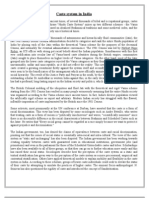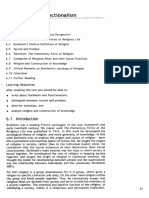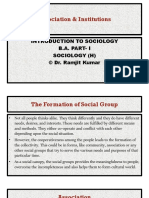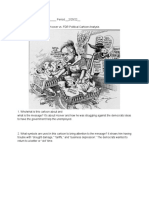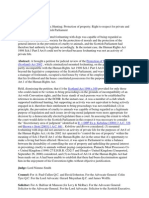Social Mobility in Caste and Class
Social Mobility in Caste and Class
Uploaded by
Raovarinder SinghCopyright:
Available Formats
Social Mobility in Caste and Class
Social Mobility in Caste and Class
Uploaded by
Raovarinder SinghOriginal Description:
Original Title
Copyright
Available Formats
Share this document
Did you find this document useful?
Is this content inappropriate?
Copyright:
Available Formats
Social Mobility in Caste and Class
Social Mobility in Caste and Class
Uploaded by
Raovarinder SinghCopyright:
Available Formats
UNIT 30 SOCIAL MOBILITY IN CASTE AND CLASS
Structure
30.0 30.1 30.2 30.3
30.4
30.5
30.6
30.7 30.8 30.9 30.10
Objectives Introduction Mobility in Caste 30.2.1 Levels of Mobility Sanskritization and Westernization 30.3.1 Sanskritization 30.3.2 Westernization Secularization 30.4.1 Education 30.4.2 SC's and OBC's 30.4.3 Industrialization and Urbanization Class and Social Mobility 30.5.1 Significance of Class Mobility 30.5.2 Class Mobility and Class Formation 30.5.3 Industrialization and Mobility 30.5.4 Education and Mobility 30.5.5 Intergenerational and Intragemational Mobility Social Mobility and Classes in India 30.6.1 Social Mobility in Agrarian Classes 30.6.2 Social Mobility in Agrarian Classes Let Us Sum Up Key Words Further Readings Specimen Answers to Check Your Progress
30.0 OBJECTIVES
to outline the processes and factors that influence mobility in caste; to describe the nature of mobility in class and the factors influencing it; and to highlight the factors influencing class mobility in India.
30.1 INTRODUCTION
Sorokin has made pioneering contribution to the analysis and study of social mobility and has contributed to conceptualization, types and channelization of it. He differentiated between societies that are 'closed' rigid, immobile and impenetrable and those that are 'open', plastic, penetrable or mobile, the nature of stratification has a bearing on the nature of mobility while caste systems is often associated with 'closed society' where avenues for mobility rare, restricted and few. Classes are found in 'open' societies7which often-ample opportunities for mobility through achievement. It is important to investigate into the nature of mobility in caste and class to find out how far they c o n f m to the generalization mentioned by Sorokin.
30.2 ,MOBILITY IN CASTE
While the general impression has been that caste is a 'closed' system of stratificatiot7s,ryet in reality it is far from true. No society is static and even in the traditional set up where ascription was the prime determinant of one's ritual and occupational standing, access to rewards and resources and social nlobility both upward and downward was not totally absent.
Social mobility in the caste system is evident in the increasing discrepancy between caste and occupations, withering away of jajmani obligations, the rigidity regarding purity and pollution and acceptance of secular lifestyle. In the olden days, Srinivas points out, there were two major sources of mobility. First was the fluidity of the political system, which made it feasible for new castes to assume the status of Kshatriyas and exercise power. Second was the availability of marginal land which could be brought under cultivation. As a consequence of these two available routes to upward mobility, leaders from dominant castes such as Reddis, Marathas could seize political power and claim Kshatriyas status. The medieval Pala d asty of Bengal was Shudra in origin. The Patridars of Gujarat originated as peasan caste. When the leader of a dominant caste escalated the rank of raja or king, it became a source of mobility for the other members and this was strengthened by and adoption of pri~ctices life styles of the upper castes.
Social Mobility in Caste and Class
l"
30.2.1 Level of Mobility
Mobility has taken place at the level of individual, family and group. Sharma has made a aarefbl analysis of these levels of mobility.
i)
Mobility of an, Individual within a family: Some individuals even though of low caste, may h h e better status and prestige compared to other members of their family. This may be on account of one's personality traits such as integrity, honesty, acquisition of education and other achievements. Similarly an individual of higher may lose his position on account of misdeeds and slothful habits. This may result in downward mobility for the individual. The individual mobility is therefore a consequence of the individual's capabilities or lack of it and hence does not influence the prestige of the caste and is least corporate in nature. Mobility of a minority of families within a caste: This kind of mobility is linked to socio-economic and political aspects of the families. The improvement in status could be result of acquisition of land and education which is fbrther reiterated by emulating the practices of higher caste with regard to dress, lifestyle and rituals. Mobility of this type is not cooperate in nature and can be viewed as 'horizontal mobility' rather than 'vertical mobility' which bridges the gap between status distinctions. Burton Stein points out that this trend was predominant in medieval period. Mobility of a majority of family or group: This kind of mobility is 'corporate' in nature. It involves collective state at prestige, honour, status and is therefore marked by changes in socio-cultural practices regarding purity and pollution. Certain castes improve their positions by discarding practices regarded impure and degrading. Sanskritization was the chief process which helped these castes to move up in hierarchy and legitimize their claim to the upward mobility.
li)
iii)
30.3 SANSKRITIZATION AND WESTERNIZATION
There are several features and processes of mobility. We now turn to these.
30.3.1 Sanslkritization
M.N. Srinivas formulated and contributed immensely to the concept of Sanskritization as a process of mobility in caste. He refers to Sanskritization as a "process by which a now Ilindu caste or tribal or other groups, changes its customs, ritual ideology and way of life in direction of a high and frequently 'twice born' castes" (Srinivas 1966) Sanskritization has tieen prevalent throughout history and has assumed various forms. It has been used as nlechanism to bridge the gap between secular and ritual rank. Whenever a caste achieved secular power it tried to legitimise its status by acquiring traditional symbols of high castes by adopting their customs, rituals.
Eleliefs and ideas such as vegetarianism and teetotalism. Besides, they tried to obtain the szrvices of Brdunin priests, visited pilgrimage centres and acquired knowledge of sacred tc:xts.
Social Mobility
The census recording was considered an excellent source of making claims to higher status. This claim according to Srinivas was upgraded in subsequent operations. For example if in one census the caste claimed to by Vaishya, in the subsequent operations it would lay claim to Brahmin or Kshatriya. This attempt was followed by attempts made by the castes to -emulate the lifestyle of the respective caste they laid claim to. The status attributes of highly ranked warrior ruler category i.e. Kshatriya and the Brahmin served as model or most upwardly mobile groups. Another very significant pattern of Sanskritization involved increasing Puritanism on the part of the castes who rejected superiority of the twice born e.g. the Koris of eastern Uttar Pradesh refused to accept water from Brahmins. Such a process of de-sanskritization contributes to crystallization of new groups and greater political mobilization. Re-sanskritization is another process in the endeavour to attain mobility. In this case formerly westernised or modernised groups discard many symbols of modernization and revert to traditional sanskritic life styles. * From the above discussion, it is clear that Sanskritizationwas a ,process of social mobility which resulted only in positional changes for particular castes and their sections i.e. the individual castes moved up or down the hierarchy while the structure remained the same.
Srinivas defines "Westernization as the changes brought about it Indian society and culture as result of over 150 years of British rule, the term subsuming changes occurring at different levels technology, institutions, ideology and values". (Srinivas 1966) Westernization is therefore a vast, multidimensional and a complex process which impinged upon various domains through a member of institutions and hence had a significant bearing on caste mobility. It not only altered the existing set up but also opened fresh avenues and doors for social mobility. A large number of inter-related factors are resp~nsible this. for Under the British rule, land became a saleable commodity and this had far reaching consequences for mobility. Ge members of low caste who could atiord to buy land could now become upwardly mobile and those who lost their rights to lands suffered downward mobility. Activity 1 Ohsewe the s~ciety a suburban village near you. How far does social interaction in confirm the westernization thesis. Make notes and compare with other students in study centre. The introduction of new means of and communication served to dilute the restrictions and inhibitions associated with caste. The British rule provided fresh avenuts for social mobility altering the nature of ?re-existing institutions such as schools and colleges which opened their doors to all castes and establishing new ones such as army, bureaucracy and law courts which recruited members on the basis of merit and hence provided ample source of mobility. Most of the new economic opportunities generated under the British rule were taken advantage of by the upper castes who availed of the educational facilities. This not to say that the lower castes were unaffected by them for example Bailey mentioned how the prohibition policy resulted in.the relative prosperity of Ganjam and Board Distillers. Similar Srinivas cites the examples of Noniyas of Western U.P. and Kolis of Surat coast who benefited from new employment opportunities resulting from railway road and canal constructions. The telis (oilmen) all over eastern India became wealthy on account of larger market and trade for oil. Westernization accelerated the mobility process in more ways than one. On one hand it was a desirable mechanism of attaining mobility, on the other, it generated mobility also / because the 'westernized' become a model for emulation for the others.
It must be noted that westernization did not begin and end with British rule. It provided tracks which hrthered and accelerated the mobility process. It set the bal! rolling which gained further momentum after Independence. The independent India took over from the rationalistic egalitarian and humanitarian principles from the British and created further room for mobility. i)'
Social Mobility in Caste and Class
'
New Legal System: The British rule resulted in the political integration of the country into a single administrative unit with a uniform and homogeneous pattern of law and order grounded in the principles of rationalism, humanitarianism and egalitarianism. These laws were sometimes in contradiction with the pre-existing ones. .For example under the traditional law punishment varied according to the caste of the person committing the offence, while the British laws treated everyone equally. The Caste Disabilities Removal Act and Abolition of Slavery were a great leap forward towards upIiftment of Iower castes. These laws were efforts in the direction of bridging the gap between lower and higher castes. Box 30.01 The principles of universalism and egalitarianism which have guided the legal
. system in India after Independence have fostered social mobility among the lower
castes. The new civil, penal and procedural law has done away with the inequities inherent in traditional law. Another important contribution ofthe new legal system was the creation of consciousness of positive rights. The abolition of untouchability and adoption of protective discrimination' policy haye proved in~mensely beneficial for the lower rung of society. The principle of universal adult franchise, adoptio'n of Panchayati Raj System have altered the distribution of power the strengthening the hands of the weaker sections and restricting the appropriation of power by the upper castes. Similarly land reforms have been a motor force affecting mobility. Ceiling of holdings have proved a blow to the status and prestige of zamindars and boon for peasant cultivators who have attained ownership rights ii) Adoption of Reforms: Whenever efforts are made at reforming the society it generates opportunities for mobility. Buddhism, Jainism and later Sikhism which are the sects of Hindu religion have disregarded,the rigidities associated with purity and pollution. They have advocated against the prevalent inequities and established a new egalitarian order within the sects. Similarly the Christian missionaries during the British rule proselytized the most oppressed castes they extricated the untouchables from a life of misery and exploitation and provided them education and health facilities. This enabled them to find new employment opportunities and attain higher status and prestige than before.
The educated liberal reformers such as Raja Ram Mohan Roy, Keshsb Chandra Sen, Swami Vivekananda, Swami Dayananda in their endeavour to reform the society got abolished evil practices such as sati, child marriage, human a sacrifice etc. To alleviate oppression and elevate the status of lower castes, they tried to infuse elements of rationality and modernity into Hindu religion. This they did by doing away with dogma and rituals associated with Hindu religion and wakening the clutches of Brahmins who they regarded as the oppressors. The new religious sects like Ary? Samaj, Rarnakrishna Mission, Brahm Samaj were egalitarian and were against disabilities and discrimination based on caste. They have played an important role in imparting education and modern knowledge and hence raising the status of their members. Mahatma Gandhi and B.R. Ambedkar fought vociferously for the upliftment of'the untouchables and their efforts bore fruits in t+e form of abolition of untouchability and the provision for protective discrimination. This has generated large scale upward social mobility among.
21
Social Mobility
SECULARIZATION
The term "secularization" implies that what was previously regarded as religious ceases to be such and it also implies a process of differentiation in the various aspects of society, economy, polity, laws and morality becoming increasingly discrete in relation to each other. In the traditional set up the principle of purity and pollution was the prime determinant of the status, ranking, occupation and the general lifestyle. With increasing emphasis on rationality and education the notion of purity pollution weakened and today it is common the see people of different castes work together in factories or rub shoulders against each other in buses and trains and even dine together in restaurants. Together with this, the manner of dress in the modem society serves to blue caste distinctions. The new law based on universalism and the constitutional recognition of equality for all citizens and the declaration of India as a secular state has served to abolish discrimination based on caste.
30.4.1 Education
Education was the prerogative of the Brahamins and 'twice born' castes ir ~ ' l e traditional set up. During the British rule educational institutions were opened to all and knowledge had a secular and rational basis. Acquisition of education opened avenues for individual and group mobility. Those trained in modem education could find jobs in army and bureaucracy which gave impetus to upward mobility. Besides this education instilled the minds of people with new principles of the justice, liberty and equality. The educated elite fought against discriminations on the basis of caste. Education had such a deep impact on the pace and pattern of mobility that it created a new middle class. After independence , in an effort to uplift the SC, ST and OBC's through education, seats have been reserved for them in educational institutions. Since then these benefits have been appropriated by a small section. It has resuited in new cleavages among these sections. These cleavages are an aspect of mobility patterns based on those who have and do not have access to education.
30.4.2 SC's and OBC's
Under this section we will analyze two main modes of mobility i.e.'mobilitythrough conflict and mobility on account of protective discrimination. For years the backward sections who were oppressed remained submissive and servile. But under British rule they improved their status and tried to legitrnise it though Sanskritization. But simultaneously, the upper castes leaped forward by usurping new opportunities. The gap between the upper and lower castes widened and this they tired to bridge by laying claim to economic and political resources. These under privileged castes consolidated themselves against the upper castes in the form of Caste Sabhas the anti-Brahmin movement date back to 1870's in Maharasthtra and were led by dominant castes such as Kamrnas, Reddis, Nayars etc. The most significant movements were launched by Mahars under the leadership of B.R. Arnbedkar. The other movements include those of 'Dalit Panthers" who united all sections of depressed people.
Activity 2
Talk to various strata of people and find out how far protective discrimination will help the SC's and OBC's Compare your notes with other students in the study centre.
These movements are illustrations for horizontal mobility and endeavours at vertical ,(upward) mobility. pradeip Bose has identified two main mobility courses i.e. movement for consolidation and movements for assertion. In thk former the caste associations tried to raise their statulthrough census operations and petitioning the rulers. These moves were legitimized through Sanskritization and maintaining distance from equivalent castes. For example Kayasthas and Bhumihar in Bihar. In the other mobility course represented economic grievances and deprivations. These castes formed associations to alter the
22
exigting pol~tlcalland economic relations. For example Yadavs, Kurmis and Keories illustrated this pattern. The backward sections have found opportunities for upward mobility on account of 'protective discrimination' policies which involves reservation of seats in educational institutions, freeship and scholarships, Besides, there are reservations in jobs and legislative bodies. These welfare measures have benefited only a small section who have claims to much higher status than their counterparts of the same caste resulting in hrther dbisions in the castes.
Social Mobility in Caste and Class
30.4.3 Industrialization and Urbanization
Industrialization accelerated the rate of social mobility in various ways. It provided employment opportunities which emphasized on achievement and qual~fications rather than caste. In the factories jobs were hierarchically graded according to qualifications and experience rather that ritual ranking. These employment opportunities were open'to all and proved a source of upward mobility for the landless labourers. Industrialization brought with it a new work set up and work culture based on technical division of labour and uniform standards. In the factories workers from different castes worked together on same machines irrespective of considerations regarding purity and pollution. Box 30.02 Most of the industries are city based and this generates migrations of work force to cities which results in urbanization. The urbanization induced by industrialization had far reaching ramifications on social mobility. In the city the lifestyles and residential patterns are no longer ordained by caste and have served to mellow down caste distinctions. The cosmopolitan set up is also responsible to inter caste marriages. The mobility in cities is largely on account of achievement through education and new occupational avenues. Class as system of stratification in replacing caste. But caste divisions are also simultaneously crystallizing in the form of caste associations, federations etc. Urbanization has created greater avenues for both vertical and horizontal mobility. Horizdnrhl mobility characterizes both caste and class in cities. Formation of caste associations is an example of former and job transfers is an illustration of the latter. Check Your Progress 1 'Tick the right answer in the following questions. i) Sanskritization refers to: a) Speaking in Sanskrit b) Spreading knowledge in Sanskrit c) A process of mobility in caste. ii) Westernization refers to: a) Brain Drain b) Changes brought about on account of British Rule. c) Apingthe western culture. iii) What is 'Protective Discrimination'? a) Policy of reservation of seats in educational institutions, legislative and jobs for weaker sections b) Policy for the upliftment of the upper classes. c) Oppression and exploitation of the untouchables.
Social Mobility
iv)
Tick the factors which have generated mobility in caste: a) Education b) Legal Reforms c) Industrialization d) Urbanization.
Those at the lower rungs of society often have to travel uncomfortably. They also have low social mobility Courtesy : B. Kiranmay i
30.5 CLASS AND SOCIAL MOBILITY
We will now discuss the significance of class and social mobility below.
30.5.1 Significance of Class Mobility
Classes are a very significant and pervasive dimension of stratification and the analysis of mobility along class lines is of crucial significance not only as an end in itself but also on account of its ramifications on other social processes. The extent of mobility has been used as a measure of the "openness" of industrial society and high mobility rates are an indication of the society being characterized by achievement rather than ascription and that it is meritocratic where individuals reap regards on the basis of their personal qualities rather than through inherited wealth and positions. Class mobility is a crucial factor for the understanding of class formation. Also, study of class mobility can provide indications of life chances of the members of society i.e. the impact of one's class of origin on life chances. Besides this, the responses and reactions of the those undergoing mobility are important for analyzing social stability and expansion. Together with these the extent of social mobility has been used as measure of "openness" of industrial society and high mobility rates are an indication of society being characterized by achievement rather than ascription.
30.5.2 Class Mobility and Class Formation
The most crucial aspect of class formation. A large number of scholars have shown keen interest in this area of study. Karl Marx was concerned about the relationship between class formation and action on the hand and the extend of mobility between class positions on the other. He was of the view that proletarianization was inimical to the process of class formation. Also in advanced capitalist societies, the expansion of middle class in based on recruitment from proletariat. Marx alkiecognized that a certain degree of immobility is seen a h indispensable prerequisite for the emergence of class consciousness. Similarly, Weber too emphasized on the significance of social mobility for class formation. Weber recognized immobility as a chief determinant for social and cultural identity of a class. Westergaard and Resler reiterate the crucial part played in shaping of class structure as a whole by the division,between those who own the capital and those who do not. They also recognise the importance of mobility and lack of it as a factor influencing peoples responses to their class situation, class consciousness and class organization. Like Westergaard and Resler, Giddcns too visualizes mobility as process of central importance to class formation. But for Giddens, its importance lies not only in the development of class consciousness and organisation as classes for themselves, it also extends back as recognizable social phenomena i.e. as 'classes in themselves'. Giddens is of the opinion that greater the restrictions on mobility i.e. greater the immobility, greater the chances for formation of distinct identifiable classes in terms of reproduction of life chances, cohesion and class solidarity. Similarly in a society with constant flux and greater mobility rate, class distinctions are blurred. Mobility is a basic source of class 'structuration' i.e. it is the rate and pattern of mobility that will determine the extent to which classes may be recognized as collectivities of individual or families occupying similar locations. Secondly, the extent of mobility may be taken as significant indicator for prevailing modes of class action. Parkin has argued that class conflict is to an important degree expressed in the formation of strategies of exclusion adopted by advantaged groups. Mobility rates and patterns serve to reveal the effectiveness of exclusion and potential success fWSsolidarism. i
Social Mobility in Castle and Class
30.5.3 Industrialization and Mobility
In the kalysis of mobility processes and patterns that term class in not used strictly in the sense used by Marx or by Weber. Rather class is viewed in terms of occupational groupings because ocppation is an aspect of one's merit, education and qualifications k d it determines one's status, prestige and salary which is turn influences the consumption patterns pattern and life chances. Industrialization has introduced a lot of changes not only in the econolhic sphere but in all realms of society. Industrial societies are referred to as 'open' societies where the opportunities for mobility are available in plenty. The high rates of mobility in industrial societies is attributed to rapid economic change which necessitates occupational geographical and social mobility to make optimum and efficient use of available talent. It is on this account that Lipset and Zettergerg feel that industrialism creates uniform mobility patterns. Duncan and Blua emphasise on a number of factors generated by industrialization that have a bearing on mobility patterns. They are of the opinion that industrialization is connected with growing rationalism which accounts for universalistic criteria for selection and upgrading occupational division of labour, weakening of Kinship and neighborhood ties. The emphasis on achievement as a criteria for selection in industrialization has generated. both upward and downward mobility. While it is clear that upward mobility is the result of the recognisation given to merit, downward mobility is the result of lack of inheritable positions of the elites. Industrialization affects the occupational patterns. In every industrialized or industrialising society there is an increase the proportion for professional official managerial and white - collar positions and decline in the proportion of unskilled labour jobs which create a surge of upward mobility. More and more.people are required to manage industry, for administration and for distribution of goods and services.
Social Mobility
30.5.4 Education and Mobility
The impetus on achievement and qualifications as determinants of one's merit has resulted in the increasing emphasis on education and training to obtain them. Education has attained a key role in facilitating mobility especially in the industrial societies. The increasing specialization and division of labour presuppose the existence of qualified personnel who can handle specialised tasks. These specialists whether in the field of industry laws, or medicine are trained and educated in specialised branches of knowledge. These educational and training facilities are open to all in the industrial societies. In the traditional set up, it was imparted to a very small number of people in the guilds which then restricted mobility. Education has been used as a route to attain upward mobility. Educational attainment is a major determinant of career mobility and deeply affects the patterns of inter-generational and intra-generational mobility discussed below.
30.5.5 Intergenerational and Intragenerational Mobility
It refers to mobility or shift (upward or downward) vis-8-vis one's parents' class. It a son or a daughter of a supervisor becomes an unskilled labour it would be downward mobility and if the same person's son or daughter becomes a manager it would amount to upward mobility. One of the first major studies on inter-generational mobility was conducted in England and Wales by David Glass in 1949. It was found that intergenerational mobility was quite high and about two-third of the persons interviewed were in a different occupational category . from that of their father. Most of the mobility was short range i.e. people were fourid in categories close to their father. Upward mobility was more common than downward mobility and was mostly concentrated in the middle levels of the class structure. Another significant study was conducted in Western Europe and U.S. It was found that cross-class mobility was about 30% for all western industrial societies and that most of the mobility was short range. They found that inter-generational mobility links the effect of family background on the occupational and socihl placement of Individuals. Educational qualifications have a bearing on mobility patterns. Those with higher qualifications were found in non-manual occupations. Also, with similar educational attainments, some of manual workers entered in manual jobs while those of non-manual workers entered manual jobs. Only college education enabled some manual workers to enter in non-manual jobs. According to Lipset and Bendix, poverty, lack of education, lack of exposure are other factors that affect mobility. Later studies by H a m r and Hout have confirmed that short range mobility is greater than long range and that mobility is more likely in the middle of socio-economic hierarchy than at its peak. Intra-generational Mobility i.e. where the individual changes soCjal position during his1 her career. For example a clerk maykpromoted to managerial cadre during his1 her career. It has been found that work like m o b i is generally less than ~ inter-generational mobility its degree depends on the first job. Work life mobility decreases with age i.e. it does not increase much after the age of 35 years. Although it is not the rule, yet worklife mobility is largely upward. It has been found that intra-generational mobility is also linked to educational qualifications and more specific the educational qualifications and more specific the educational training less the scope for mobility. According to Lipset and Bendix self employment is one of the few means i f the acquiring higher positions and mobility among manual workers.
30.6 SOCIAL MOBILITY AND CLASSES IN INDIA
Very often it is expressed that classes in India are a result of social mobility induced by British rule in India. This statement is far from true because classes did exist in pre-British times. However, it cannot be denied that in the traditional set up caste system was more predominant system of stratification. In the present set up classes and castes have co-existed as dynamic systems and have interacted to create a complex and multi-dimensional empirical reality. It is only for analytical purposes that the following different class strata are being identified.
3816.1 Social Mobility in Agrarian Classes
In the traditional set up load could be brought or sold and was a source of great prestige. During the British rule land became a saleable cgmmodity and it had serious repercussion on the nature of agrarian reIations and on socio mobility. The introduction of land reforms in th_e 1950 which aimed at abolishing the intermediaries, such as the Zamindars and providing land to the tiller generated vertical mobility - both upward and downward. While some tenants could buy surplus land and become upwardly -*dobile, others were t h r o w out by the Zamindars who claimed to be the cultivators. This resulted in the pauperization of the landless labourers, land reforms were also a source of downward mobility for the Zamindars. They lost their right to extract taxes and share from the cultivators which was a source of their wealth. They were left with fragmented holdings which could not support their feudal lifestyle. With the introduction of legal measures such as introduction of panchayats and universal aduJt franchise, they felt uncomfortable for their influence and power waned. Green Revolution programme launched by the government in 1960's has also altered the pattern of inequalities inthe villages.,The emphasis of this programme was on the use of High Yielding variety seeds and use of fertilizers for increasing productivity. But these seeds and fertilizers also required other basic infrastractural facilities such as tubewells for regular water supply. These along with other requirements cannot be afforded by small peasants. A new class of 'Progressive Farmers' have come to characterize the villages under the Green Revolution Programme. They have large land holdings and can afford to invest in resources like tractors, pumpsets, power threshers etc. These progressive farmers are entrepreneurs who invest in land to reap profits. They are a distinct class who are separated from the small farmers and from the agricultural labour whom they employ Green revolution has thus further reinforced social inequality. The increasing prosperity of the rich landlords at the cost of pauperization of the workers has generated conflict and strife in the agtarian set up. Political mobilization of the agrarian classes on an all India basis started during the freedom struggle. This continues even today, although the spread and intensity of mobilization varies across regions, classes and time periods. It is now clear that a large number of processes have influenced the nature of agrarian classes and mobility among them. They have been measures and mechanism for the formation of new castes and the upward and downward mobility of the existing ones.
Social Mobility in Caste and Class
38.6.2 Social Mobility in Urban Classes
U$qnization is not a new phenomena for Indian society. During the pre-British period, there were a large number of cities with a district pattern of ranking and.administration. After industrialization, the resultant urbanward migration has been rapid and enormous. This has grossly affected the nature of the social classes. There we four major classes,that can be identified in an urban set up. These include:
i)
The capitelists/bourgeoisie: The Britishers introduced modem industrialization in India. The setting up of industries, free trade and new markets gave impetus to trade and commerce. The traders became wealthier and took to industry. It is noteworthy that even today a large number of industrialists hail from trading castes and communities such as Marwaries in Rajasthan, Gujarati Banias and jains in the west, Chettiars and the South. The merchant class was the first to become capitalist. Certain artisans and craftsmen who availed of the new economic opportunities also set up small scale factories. The Jatavs of Agra studied by Lynch have taken to shoe manufacturing some landowning castes too become industrialists, these include Patidars of Gujarat, Naidus and Reddies of Andhra Pradesh.
Industry has expanded immensely after iddependence and diversified into all fields ranging from iron and steel, textiles, automobiles, electronics to aeronautics. The class of irldustrialists has ,become economically and numerically stronger.
Social Mobility
ii)
Entrepreneurs Traders and Shopkeepers: Urban society always comprised of entrepreneurs who included traders and shopkeepers. These classes have flourished htw of cities and towns and cashed on the rising demands and expandedw of new goods and services in them. This class would include entrepreneurs running restaurants, marriage bureaus, video libraries and other like property dealers, grocers, laundered, dry cleaners, vegetable renders who are a direct link between suppliers of goods and service and consumers. A large number of people have become wealthy by joining this rung of class structure in the cities while some have diversified and expanded in their traditional occupations and arts such as Dhabi's taking to dry clearing and barbers opening beauty parlours. Other have established absolutely new enterprises and other consumer durables, travel agencies etc. Professional Classes: This class has undergone vast changes in its nature and complexion on account of the changes introduced under the British rule and after independence. The British required a large body of professionals for various purposes. They felt it was cheaper to educate Indians for the same. Hence a large number of educational institutions were established to train professionals. This class included doctors, lawyers, managers, bureaucrats scientists, technocrats etc.
iii)
With the expansion of tertiary sector, this class has expanded both in size and prestige. Even though it ista highly heterogeneous class comprising of those ranging from clerk9 to C.A.'s, Babus to bureaucrats, yet one factor that characterizes them all is that they have achieved their status through qualifications that befit their positions. The members of this class have made use of education and training to attain their positions. Another common feature of this class is that a large majority of them are salaried employees of state or private sector, they are neiiher direct rulers nor economic producers like industrialist of peasants. iv) Working Class: Studies have shown that the earliest working class population comprised of pauperized agricultural labour who were landless or impoverished peasantry who had mortgaged their land. The later joined the labour force on a short term basis as 'target workers' to earn a fixed sum of money to be able to get back their land, Others joined as seasonal workers in search of work during slack periods in agriculture. These workers worked in factories, textile mills. Plantations, and in informal sectors what characterized them all was abject living conditions in slums.
With the expansion of industry in recent decades, working class has expanded and diversified into various industrial set ups in all ports of the country. They have organized themselves into unions to enter into better bargaining positions with their employers. These trade unions have political affixations and have raised their leaders to position of power land prestige and mediators between management workers. The workers have provisions for both intra and inter-generational mobility. They can opr for change in the industrial unite they work for, on the basis of pay structure and work conditions. Besides vertical mobility, the workers also depict horizontal mobilization in terms of labour unions, clubs associations etc. Check Your Progress 2 Tick the right answer in the following questions. 1) Inter-generational 'Mobility refers to: a) b)
2)
Mobility during a persons worklife. Mobility on account of Migration.
hid of mobility (upward or downward) vis-it-vis one's parents c) The factors responsible for mobility in the agrarian set up in India are:
a)
b) c) d) Land Reforms Green Revolution Programme White-Collar Jobs a) and b)
,3)
The four major classes that are found in Indian cities are: a) b) c) Bourgeoisie, Entrepreneurs, Kisans and Bpurgeoisie, Entrepreneurs, Professionals and Zamindars
Social Mobility in Cmte and Class
bourgeoisie, Entrepreneurs, Professionals and working class.
30.7 LET US SUM UP
It can be noted from the above discussion on social mobility that even in so called 'closed' system of stratification, there is constant effort among members to improve their social positions through the means available to them. As we have seen in India, some of the mechanisms and progresses involved in social mobility were culture specific as is the case of Sanskritization. The new avenues for mobility provided by education, urbanization and industrialization were quickly united for advantageous shifts in hierarchy. Industrialization and urbanization have played at vital role in generating mobility both in the caste and class societies by emphasizing on the role of achievement and skill acquired through educatioh. These twin processes have widened the horizons the horizons for vertical and horizontal mobility. In India caste mobility and class hierarchy co-exists, intermingle and have resulted in a complex arid multi-dimensional pattern of stratification and mobility where the two may or may not be co-terminoug
30.8 KEY WORDS
Sanskritization
:
It is a process of social mobility in caste whereby a low caste may change its customs, lifestyle, rituals and ideology in the direction of high castes mainly Brahmins and Kshatriyas. Emulation is the main process involved here. It is a term used to describe the changes that came about as a result of British rule in India. These changes include those at . the level of technology, institutions, ideology etc. Westernizations opened new doors for mobility at the level of individuals and castes.
Westernization
30.9 FURTHER READINGS
Gupta D. (Ed.) (1992). Social Stratifcation Delhi: Oxford University Press. Unit IV. Sharma, K.L.1997: Social Stratification in 1ndia:lssues and Themes, New Delhi: Sage Publications.
,r.-
30.10 SPECIMEN ANSWERS TO CHECK YOUR PROGRESS
Check Your Progress 1
i) ii)
c b
iii)
iv)
a, b,c and d
You might also like
- Bir 2303Document1 pageBir 2303Melissa Baday80% (5)
- Eng ConditionalsDocument14 pagesEng ConditionalsKimberly DeLa CruzNo ratings yet
- Sanskritization and WesternizationDocument16 pagesSanskritization and WesternizationAnuj RakkanchathNo ratings yet
- Caste, Varna and JatiDocument7 pagesCaste, Varna and JatiSuman DasNo ratings yet
- Sanskritization and WesternizationDocument14 pagesSanskritization and WesternizationArvind GuptaNo ratings yet
- Course Name-B.A.L.L.B.Ivth Sem Subject - Sociology Teacher - Dr. Niru Jain Topic - Sanskritization, Westernization, ModernizationDocument24 pagesCourse Name-B.A.L.L.B.Ivth Sem Subject - Sociology Teacher - Dr. Niru Jain Topic - Sanskritization, Westernization, ModernizationClark KennttNo ratings yet
- Caste MobilityDocument6 pagesCaste MobilitySubhojit Das0% (1)
- 3 Sacred The Profane PDFDocument3 pages3 Sacred The Profane PDFfrancis allanNo ratings yet
- 21B.Riddles in Hinduism PART II PDFDocument71 pages21B.Riddles in Hinduism PART II PDFVeeramani ManiNo ratings yet
- Emile Durkheim's Perspective On ReligionDocument3 pagesEmile Durkheim's Perspective On ReligionFilozotaNo ratings yet
- Causes of Indian National Movement Modern Indian History Notes For UPSCDocument3 pagesCauses of Indian National Movement Modern Indian History Notes For UPSCSaurabh YadavNo ratings yet
- Impact of Colonial Rule On IsDocument34 pagesImpact of Colonial Rule On IsSayali ManekarNo ratings yet
- Village Studies Tradition in IndiaDocument14 pagesVillage Studies Tradition in IndiaAnkit SarafNo ratings yet
- UNit 6 PDFDocument13 pagesUNit 6 PDFAnkit SinghNo ratings yet
- LAWPBALLB209944rStarPr - Gandhian PrinciplesDocument3 pagesLAWPBALLB209944rStarPr - Gandhian PrinciplesSri MuganNo ratings yet
- Caste in Contemporary IndiaDocument3 pagesCaste in Contemporary Indiasheilnandni kaushalNo ratings yet
- Casteism, Anti-Brahmin Movements and Indian PoliticsDocument16 pagesCasteism, Anti-Brahmin Movements and Indian PoliticsSangram007100% (1)
- Changes in The Indian Family - A. M. ShahDocument4 pagesChanges in The Indian Family - A. M. Shahchonky bearNo ratings yet
- Rural India Gandhi, Nehru and AmbedkarDocument12 pagesRural India Gandhi, Nehru and AmbedkarMarcos MorrisonNo ratings yet
- Fundamentalism, Communalism and Secularism PDFDocument14 pagesFundamentalism, Communalism and Secularism PDFpravingulia100% (1)
- Social Status & Social Role. Topic 3Document4 pagesSocial Status & Social Role. Topic 3Ahmed Mujtaba100% (1)
- Institution and AssociationDocument20 pagesInstitution and AssociationRamjit KumarNo ratings yet
- Role of Civil Services in A Democracy 1Document17 pagesRole of Civil Services in A Democracy 1Sarthak SouravNo ratings yet
- Systems of Kinship in IndiaDocument11 pagesSystems of Kinship in IndiaArvind Chari100% (1)
- Sanskritisization and WesternisationDocument17 pagesSanskritisization and WesternisationAyush Gaur100% (1)
- Sociology Ug PDFDocument13 pagesSociology Ug PDFAnoyan SuganthiNo ratings yet
- Unit III Caste & ClassDocument20 pagesUnit III Caste & ClassKhushi ThaparNo ratings yet
- Green RevolutionDocument7 pagesGreen RevolutionShailjaNo ratings yet
- Third Gender: Presentation ONDocument40 pagesThird Gender: Presentation ONProshad BiswasNo ratings yet
- Gandhi & SarvodayaDocument13 pagesGandhi & SarvodayaAAYUSHI SINGHNo ratings yet
- Sociology As ScienceDocument20 pagesSociology As ScienceStudyDhaba ComNo ratings yet
- Gs Ghurye Socio 3Document28 pagesGs Ghurye Socio 3Rohan MittalNo ratings yet
- Structural MarxismDocument3 pagesStructural MarxismmoschubNo ratings yet
- Social StratificationDocument2 pagesSocial StratificationSaurabhNo ratings yet
- Partition of IndiaDocument13 pagesPartition of IndiaWin Nwe OoNo ratings yet
- Caste and WomenDocument20 pagesCaste and WomenRamjit KumarNo ratings yet
- Women - SociologyDocument23 pagesWomen - SociologyAnay Mehrotra100% (2)
- Gender DiscriminationDocument14 pagesGender DiscriminationRaghu YadavNo ratings yet
- SM1 - Lesson 1 To 15Document238 pagesSM1 - Lesson 1 To 15nksNo ratings yet
- Chanakya National Law UniversityDocument38 pagesChanakya National Law UniversityDiksha SinghNo ratings yet
- Function of Caste SystemDocument2 pagesFunction of Caste SystemVishnuKayandeNo ratings yet
- Sociology 3 Module-IVDocument11 pagesSociology 3 Module-IVAnushka SharmaNo ratings yet
- Vedic Age - Later Vedic Period (Aryan Age) - History NotesDocument11 pagesVedic Age - Later Vedic Period (Aryan Age) - History NotesAquib IrshadNo ratings yet
- Abhinav Socio NaxalismDocument31 pagesAbhinav Socio NaxalismMuskan KhatriNo ratings yet
- Caste and Indian Politics Notes PDFDocument7 pagesCaste and Indian Politics Notes PDFaniket akshayNo ratings yet
- Women's Movement Notes/assignmentDocument19 pagesWomen's Movement Notes/assignmentRoly Kumari Singh100% (1)
- Assignment: International Islamic University IslamabadDocument6 pagesAssignment: International Islamic University IslamabadAnusha 1425-FSS/BSSOC/F21100% (1)
- A 1 - AR DesaiDocument4 pagesA 1 - AR DesaiAman KatiyarNo ratings yet
- Women Participation in Swadeshi Movement-A Study of Cachar District of South AssamDocument6 pagesWomen Participation in Swadeshi Movement-A Study of Cachar District of South AssamIOSRjournalNo ratings yet
- Rajni Kothari (Editor) - Caste in Indian Politics (1985, Sangam Books LTD) - Libgen - LiDocument400 pagesRajni Kothari (Editor) - Caste in Indian Politics (1985, Sangam Books LTD) - Libgen - LiLov KrNo ratings yet
- Modernity and Social Changes in Europe and Emergence of SociologyDocument5 pagesModernity and Social Changes in Europe and Emergence of SociologyakshayNo ratings yet
- Anti Caste MovementDocument14 pagesAnti Caste Movementvanshika negiNo ratings yet
- Social Reform MovementsDocument8 pagesSocial Reform MovementsRadhika GoelNo ratings yet
- IGNOU Social and Political Thoughts (MPSE-004)Document188 pagesIGNOU Social and Political Thoughts (MPSE-004)Dharma GnaniNo ratings yet
- Positivist Approach: Approaches in Social ResearchDocument11 pagesPositivist Approach: Approaches in Social ResearchNazra QureshiNo ratings yet
- CommunalismDocument26 pagesCommunalismfunny manNo ratings yet
- Young India: An interpretation and a history of the nationalist movement from withinFrom EverandYoung India: An interpretation and a history of the nationalist movement from withinNo ratings yet
- Quick Facts Related To Civil Services 201 4Document1 pageQuick Facts Related To Civil Services 201 4Raovarinder SinghNo ratings yet
- Gujral DoctrineDocument24 pagesGujral DoctrineRaovarinder SinghNo ratings yet
- Two Down, What Next - The HinduDocument1 pageTwo Down, What Next - The HinduRaovarinder SinghNo ratings yet
- DemocracyDocument26 pagesDemocracyRaovarinder SinghNo ratings yet
- Sociological ToolsDocument1 pageSociological ToolsRaovarinder SinghNo ratings yet
- Current Affairs 2010 WWW - UpscportalDocument141 pagesCurrent Affairs 2010 WWW - UpscportalMayoof MajidNo ratings yet
- 2011 Indian Anti-Corruption MovementDocument20 pages2011 Indian Anti-Corruption MovementRaovarinder SinghNo ratings yet
- Civil Services MentorDocument143 pagesCivil Services MentorManoj Kumar TewariNo ratings yet
- Current Affairs 2010 WWW - UpscportalDocument141 pagesCurrent Affairs 2010 WWW - UpscportalMayoof MajidNo ratings yet
- 2011 Indian Anti-Corruption MovementDocument20 pages2011 Indian Anti-Corruption MovementRaovarinder SinghNo ratings yet
- SAARCDocument2 pagesSAARCRaovarinder SinghNo ratings yet
- Geography MapsDocument4 pagesGeography MapsRaovarinder SinghNo ratings yet
- Rewriting Indian History by F GautierDocument247 pagesRewriting Indian History by F GautierArya Veer100% (6)
- 5 Corporate Social ResponsibilityDocument30 pages5 Corporate Social ResponsibilityE-ሽገር Online bussinessNo ratings yet
- Letter Re Paul Rusesabagina 12.18Document3 pagesLetter Re Paul Rusesabagina 12.18Fares SabawiNo ratings yet
- SSLG - Bonfal NHS Constitution and By-Laws (Revised)Document22 pagesSSLG - Bonfal NHS Constitution and By-Laws (Revised)seigfred john BallesterosNo ratings yet
- Criminal Law I - Amurao NotesDocument139 pagesCriminal Law I - Amurao NotesCar L Mina100% (1)
- Certified List of Candidates For Congressional and Local Positions For The May 13, 2013 2013 National, Local and Armm ElectionsDocument2 pagesCertified List of Candidates For Congressional and Local Positions For The May 13, 2013 2013 National, Local and Armm ElectionsSunStar Philippine NewsNo ratings yet
- Lesson 3: Democracy in The Philippines: Philippine Politics and Governance 2 QUARTER 2021Document11 pagesLesson 3: Democracy in The Philippines: Philippine Politics and Governance 2 QUARTER 2021Princess Oniot100% (1)
- 2019.Consti2.List of Cases - Freedom of ReligionDocument2 pages2019.Consti2.List of Cases - Freedom of ReligionDreamCatcherNo ratings yet
- Test Type Bac CorrectionDocument7 pagesTest Type Bac CorrectionAngel Angeleri-priftis.No ratings yet
- HM 111-Pakistan Studies (Outline)Document6 pagesHM 111-Pakistan Studies (Outline)Yasir MalikNo ratings yet
- Normative Theory of The PressDocument5 pagesNormative Theory of The PressMarcelo Alves Dos Santos Junior100% (2)
- ADINOLFI, Goffredo - The Fascist Ministerial EliteDocument13 pagesADINOLFI, Goffredo - The Fascist Ministerial EliteAnonymous 1WG7xK100% (1)
- New Section 17-A of Prevention of Corruption Act Promotes, Rather Than, Prevents CorruptionDocument9 pagesNew Section 17-A of Prevention of Corruption Act Promotes, Rather Than, Prevents CorruptionAtul krishnaNo ratings yet
- Theoretical Framework: LGBT - Research - PDF, N.D.)Document3 pagesTheoretical Framework: LGBT - Research - PDF, N.D.)Hannah JaneNo ratings yet
- Article VI - Legislative DepartmentDocument16 pagesArticle VI - Legislative DepartmentCarlo GulapaNo ratings yet
- Pi Upr27 Tun e Main RevDocument15 pagesPi Upr27 Tun e Main RevFake BotNo ratings yet
- Cartoon Analysis 2Document6 pagesCartoon Analysis 2Camille PoloNo ratings yet
- The Non-State Actor and International Law: A Challenge To State Primacy?Document19 pagesThe Non-State Actor and International Law: A Challenge To State Primacy?Bassem IsamilNo ratings yet
- Alliances & BOPDocument2 pagesAlliances & BOPASMA ASLAMNo ratings yet
- Magtajas vs. Pryce Properties Corp., G.R. No. 111097, July 20, 1994Document8 pagesMagtajas vs. Pryce Properties Corp., G.R. No. 111097, July 20, 1994Marianne Hope VillasNo ratings yet
- People V Sanchez With ScraDocument3 pagesPeople V Sanchez With ScramonchievaleraNo ratings yet
- Disaster and Human SecurityDocument12 pagesDisaster and Human SecurityJoko Setiyo KurniawanNo ratings yet
- Adams V Scottish MinistersDocument1 pageAdams V Scottish MinistersLee MarsdenNo ratings yet
- 8 MatDocument12 pages8 MatBEALU GIRMAYENo ratings yet
- Certified List of Candidates For Congressional and Local Positions For The May 13, 2013 2013 National, Local and Armm ElectionsDocument2 pagesCertified List of Candidates For Congressional and Local Positions For The May 13, 2013 2013 National, Local and Armm ElectionsSunStar Philippine NewsNo ratings yet
- TREATY of ParisDocument9 pagesTREATY of ParisLieo Marco Rosario BaniquedNo ratings yet
- Preamable ARTICLE I ARTICLE II CompleteDocument79 pagesPreamable ARTICLE I ARTICLE II CompletevinaNo ratings yet
- 1906 Cac 008Document1 page1906 Cac 008bernicetsyNo ratings yet




